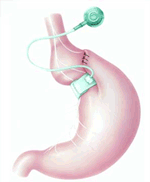The more you know about the LAP BAND System procedure, the easier the process should be for you.

Before your surgery, you should talk about the procedure in detail with your surgeon. Your doctor may also want you to meet with other experts. They can help you understand what will happen during and after the operation. These experts might include operation, the band part of the LAP BAND System will be fastened around the upper part of your stomach. This will create a small stomach pouch. Part of the lower stomach will then be sutured over the band. The rest of the lower stomach will stay in its normal position. The reservoir for adjusting the band will be placed under your skin. To do this, the surgeon will slightly enlarge one of the incisions that he or she made for the laparoscopic tubes.
A number of examinations have to be carried out before a patient can undergo surgery The patient also needs to visit a dietitian. The dietitian may give him or her a food diary in order to obtain a comprehensive picture. The aim is that the patient should keep a detailed diary of what he or she eats for a week. This diary is used to assess whether surgery will be helpful. We can only decide to carry out the operation involving a band around the stomach once we have the green light from all quarters. The patient is usually admitted the day before the operation. The results of all the examinations are checked again. Then I again explain to the patient what the operation involves, and the anesthesiologist talks to him or her about the anesthesia and the form of pain relief that will be used after the operation. When the patient has been admitted, he or she is also seen by a physiotherapist, with the emphasis being on respiratory therapy. After the operation, the patient may find it less easy to breathe deeply, and it may be painful to cough up mucus. So before the operation, the physiotherapist gives the patient instructions on the correct way to breathe and cough, so that post-operative treatment can be carried out efficiently and well." (LAP BAND System surgeon)
Sometimes laparoscopic surgery can't be done. Or sometimes, even after the laparoscopic surgery has started, the surgeon may switch to the "open" method. There could be a number of reasons for this. For instance, bleeding or problems placing the band could make the open method with the larger incision necessary. If this is the case, you will not be aware of it while you are under the anesthesia. The surgeon will make a larger incision in the abdomen to perform the operation. After this "open" surgery, you will most likely need to stay in the hospital longer. That's because there could be more complications. It also may take more time for you to get back to your normal routine. In the U.S. study about 5% of the patients were converted to open procedures.
Once the anesthesia has worn off, you may feel some pain. This pain can usually be relieved with ordinary painkillers. The hospital staff will help you get out of bed and start moving as soon as possible. This will help prevent blood clots, respiratory problems, and bedsores.
On the day after the surgery, you will likely be given an X-ray. This is so your health team can see that the LAP BAND System is in the right place. It is also to see that the new stomach outlet is open. You may be asked to swallow a liquid that can be seen on X-ray.
After a laparoscopic surgery, you will normally stay in the hospital for 1 to 3 days. The hospital stay may be longer after the open procedure or if there are complications. If there are no complications, you should be able to resume normal activities within a week or two after the surgery.